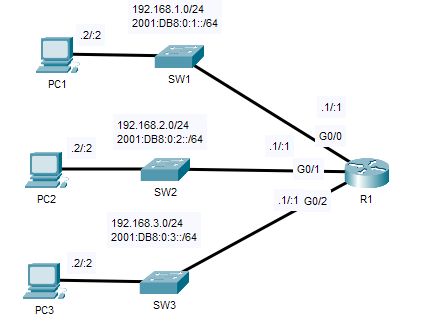
The IPv4 configuration of each device is complete.
Perform the following IPv6 configurations to create an IPv4/IPv6 ‘dual-stack’ network.
Enable IPv6 routing on R1.
Configure the appropriate IPv6 addresses on R1.
Confirm your configurations.
What IPv6 addresses are present on each interface?
Configure the appropriate IPv6 addresses on each PC.
Configure the correct default gateway.
Attempt to ping between the PCs (IPv4 and IPv6)
1. Enable IPv6 routing on R1.
1
2
3
4
5
6
7
8
9
10
11
12
13
14
| R1(config)#ipv6 ?
access-list Configure access lists
cef Cisco Express Forwarding
dhcp Configure Ipv6 DHCP
general-prefix Configure a general IPv6 prefix
host Configure static hostnames
local Specify local options
nat NAT-PT Configuration commands
neighbor Neighbor
route Configure static routes
router Enable an IPV6 routing process
unicast-routing Enable unicast routing
R1(config)#ipv6 unicast-routing
R1(config)#
|
1
2
3
4
5
6
7
8
9
10
11
12
| R1(config)#int g0/0
R1(config-if)#
R1(config-if)#ipv6 address 2001:db8:0:1::1/64
R1(config-if)#
R1(config-if)#
R1(config-if)#int g0/1
R1(config-if)#
R1(config-if)#ipv6 address 2001:db8:0:2::1/64
R1(config-if)#
R1(config-if)#int g0/2
R1(config-if)#
R1(config-if)#ipv6 address 2001:db8:0:3::1/64
|
3. Confirm your configurations. What IPv6 addresses are present on each interface?
1
2
3
4
5
6
7
8
9
| R1(config-if)#do show ipv6 int br
GigabitEthernet0/0 [up/up]
FE80::201:97FF:FE9A:AC01
2001:DB8:0:1::1
GigabitEthernet0/1 [up/up]
FE80::201:97FF:FE9A:AC02
2001:DB8:0:2::1
GigabitEthernet0/2 [up/up]
FE80::201:97FF:FE9A:AC03
|
5. Attempt to ping between the PCs (IPv4 and IPv6)
